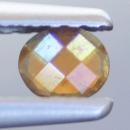|
|
||||||||||||||||
|
||||||||||||||||
|
||||||
|
|
|
|
Iridescent
"Rainbow" Garnet
(variety
of Andradite
Garnet)
|
|
| | |
| Discovered in 1934; IMA status: Not Valid (variety name) | ||
|
| ||
|
|
|
|
More Information |
|
|
|
|
|
|
Rainbow
Garnet
is a variety of Andradite
Garnet. |
|
Type Locality: |
Adelaide mining district, Nevada, USA |
|
Year Discovered: |
1934 |
|
View mineral photos: | |
|
Mineral information: |
Mindat.org (Andradite) |
|
|
|
|
Rainbow Garnet has also been found in Mexico at a mine located about 200 kilometers southeast of Hermosillo in Sonora, Mexico. This was the main source of iridescent Garnet until the discovery in Japan in 2004. Rainbow Garnet from Japan was first found in early 2004 by several groups of mineral collectors near the old Kouse Magnetite mine in the Tenkawa area of Nara Prefecture located approximately 60 km southeast of Osaka. The Garnets found here were not high quality but in September 2004 a local mineral collector named J. Sugimori found an outcrop containing gem-quality, strongly iridescent and relatively clean Andradite Garnet crystals. Over the next four months, he used hand tools to follow the vein to a depth of 5 m. Several hundred kilograms of well-formed Rainbow Garnet crystals showing spectacular iridescence were recovered. A small portion of this material could be considered gem quality. In August 2005, local authorities from Tenkawa village prohibited additional Garnet recovery from the area. This source is now closed and off-limits and mostly overgrown by forest. Collecting at this location is strictly prohibited and field collectors have been arrested. The Rainbow Garnet from this location occurs as relatively small crystals with an orangy brown body color but exhibit a variety of iridescent colors depending on the viewing orientation and the particular crystal face. The phenomenon varies from a single color to a range of colors that shifts as the gem is rotated. Some crystal faces can even exhibit a full spectrum of colors, or a "rainbow" of colors. The crystals from this location are nearly pure Andradite, as determined by their chemical composition. Microscopic examination shows the presence of a rather complex lamellar, or thin-layered, structure. These alternating, microscopic layers are of slightly different composition and varying widths. Some layers are nearly pure Andradite, others are Andradite with a Grossular component. These microscopic layers were formed by crystal intergrowth, distortion and possibly twinning. This complex structure is responsible for the iridescent colors by diffraction of light through and bouncing off of the many microscopic layers. (GIA Gems & Gemology, Winter 2006) Rainbow Garnet crystals are beautiful
and popular but faceted gems are very rare. This is due to the thin
layers of iridescence being so close to the
surface of a crystal. Polishing of facets too deeply
will polish the iridescence right off. Also,
only a very small percentage of
the crystals are facetable. Most crystals are completely opaque. A translucent gem
would necessarily be small. A gem
with nice symmetry and translucency is quite rare. The gem pictured above is
a rare and beautiful example of a small, translucent
gem with excellent rainbow iridescence. As the gem is rotated the various facets
light up with the iridescent rainbow flash. |
|
We
have not photographed our Rainbow Garnet
gems
yet. Please
check back soon. |
